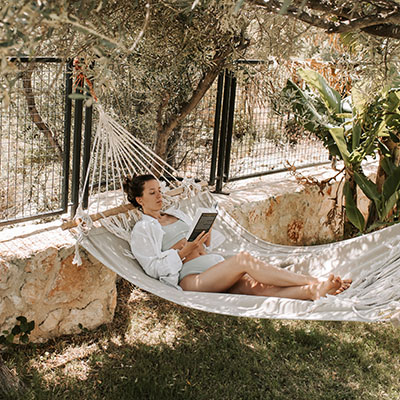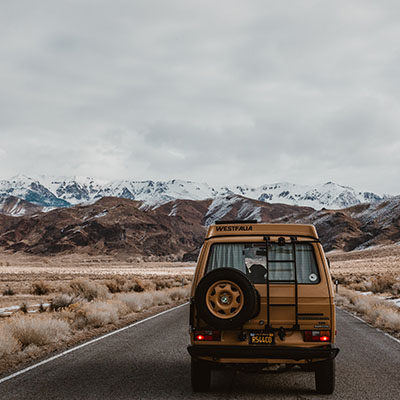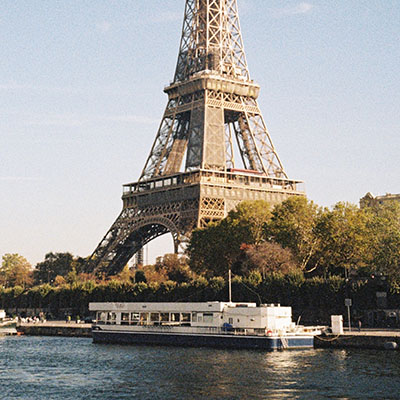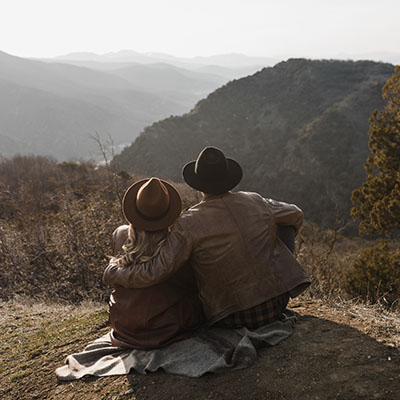It's a dilemma for travels across the globe: do as much as you possibly can? or slow down and experience a destination more deeply? Striking the right balance between sightseeing and immersing yourself in local culture can make or break a trip. Explore slow travel and see if this type of travel is what you've been craving for more meaningful experiences.
What Is Slow Travel?
Slow travel is all about connection. It’s about seeing and experiencing a place at a pace that allows you to process those sights and experiences. Ultimately, according to Condé Nast Traveler, “It comes down to how you engage with the world as you move through it.”
Slow travel is the antithesis of our everyday hectic lives, where we go from one meeting to the next, scarfing down a quick meal between school activities, and wondering where the week (or heck, the year) has gone. It’s the opposite of “regular” travel. In other words, it bucks the trend of getting to our destination as quickly and conveniently as possible, only to leave it immediately to get to the next site and the next and the next.
Think of it in terms of the slow food movement. In the backlash against fast food some 40 years ago, we came to see “slow food” as a healthier, more authentic way to eat. We didn’t think much of “slow food” at all — it was just regular food — until we were faced with the alternative, and then we weren’t sure how much we liked it.
So today we have slow travel as one way we can move through the world in a healthier, more authentic way.
Examples of Slow Travel
Because no two travel experts can agree on a specific definition of slow travel, there are actually plenty of examples and ways you can customize your trip.
 Nothing-cation
Nothing-cation
Expedia reported at the beginning of 2023 that 96% of travelers planned to spend a portion of their first trip of the year doing absolutely nothing. Feelings of burnout from the holidays was a major reason for this.
When you’re feeling burned out from everyday life, a nothing-cation where you avoid activity and plans as much as possible can feel like a breath of fresh air. Read books for fun, watch movies for hours on end, order out instead of cooking, stare off into the distance, listen to the rain.
FOMO — the fear of missing out — doesn't seem to be a deterrent from taking a nothing-cation. More than 60% of the travelers in Expedia’s survey said that doing nothing was their favorite part of their trip and that they thought it was time well-spent.
Home base
Booking a vacation rental is a good option for someone who wants a nothing-cation or who wants to do something but not too much. When you get the itch to get out and explore a bit, you can use the vacation house as a home base. Take the bus, bike, or walk to that museum you want to leisurely peruse, then return “home” for the night. The next day, you can meander in the other direction, but only if the mood strikes you.
In addition to giving yourself a chance to breathe, you’re reducing your environmental footprint by staying in one spot for a bit longer. We like this option for when you want some relaxation while still getting out and about for new experiences.
 Road trip
Road trip
Road trips are great for slow travel because you’re in control of your pace. When you fly or use public transportation, you’re at the mercy of someone else’s schedule. Not so when you’re behind the wheel.
For the ultimate in slow travel road trips, don’t book hotels along your route. Don’t even commit to a route in the first place. Choose a direction and start driving. If something catches your attention, stop to take a look. Let serendipity be your guide.
Embrace small towns along the way. They tend to be less touristy and give you a better glimpse at “real life.”
Farm stay
The opposite of a nothing-cation, doing a farm stay involves a bit of physical labor. Farm stays involve working at a ranch, farm, or orchard in exchange for room and board. It can be a good way to get to know the land and build personal connections with other people. It’s also a great option for budget-friendly travel.
Lest you be concerned that the only thing you’ll see on your trip is the inside of a barn, many of the organizations that host farm stays only ask that you work part of the day. You have the rest of your time to explore at your leisure.
 Barge cruise
Barge cruise
Just about any cruise can be turned into slow travel, but a barge cruise truly fits the bill. Particularly in Europe, barge cruises are most common on rivers and canals, and compared to a typical river cruise, they cover less distance at slower speeds.
Traveling on smaller waterways gives you time to get off the boat and explore if you choose. We’ve even seen some barge cruises that have bicycles on board. This is by design so, while the barge is going through one lock, you can hop off and ride down the path to meet it at the next.
Barge cruises also typically have fewer passengers, daily schedules are more flexible, and when you’re on shore, you visit less-populated areas. Getting away from the typical cruise ports and tourist cities gives you a chance to travel differently and at your own speed.
Trekking
Much like road trips, trekking allows you to move 100% at your own pace, as fast or slow as your own two feet can carry you. If you want to try trekking for your slow travel experience, consider a multi-day backpacking trip, or simply book a cabin or room in a park lodge and take short hikes throughout your stay.
We love this option for its ability to put you at the heart of nature and because it’s so accessible. It’s a realistic option for most travelers, no matter your fitness level, whether you want to hike in mountains or desert, or have a month to travel or just a long weekend.
Adult gap year

One note of caution, however. Studying abroad, whether formally with a school or on your own as part of a gap year, can quickly stray away from the idea of slow. Find balance between your slow travel itinerary and your growth goals. Make time for breaks and self-reflection, and allow yourself the opportunity to follow your curiosity, even if it’s not on the syllabus.
Train ride
Some of my favorite memories of visiting Scotland for the first time weren’t of the castles and haggis, but of the train ride I took north from England to get there. I had nothing to do but watch the landscape rumble by, write in my journal, and let the experience soak in.
Train travel is the definition of “It’s all about the journey, not the destination.” This isn’t about getting from Point A to Point B. Book a berth on a train and let the ride itself be the trip.
Let yourself get bored. You might be surprised where your mind goes when you do. The lack of busy activity and the freedom to let your mind wander are how we come up with new ideas. It’s why we come home with fresh perspectives and a better understanding of ourselves and our place in the world. There are other ways to stay entertained if we just take the time to notice them.
How to Do Slow Travel
Choose a destination that lends itself to slow travel.
This doesn’t mean that you automatically book a cabin in the woods, although you might enjoy that. Slow travel, says AARP, “encourages visitors to go beyond the most popular, fast-paced destinations.” Stay in a treehouse on the outskirts of town if you want. Or go ahead and book a city escape. Just tweak your itinerary to adjust to a slower pace and take advantage of sites off the regular tourist track.
Rather than book a hotel in the city center, pick a rental house where you can cook your own meals, lounge on a couch rather than propping yourself up in bed when you want to read, or set up a jigsaw puzzle on a large kitchen table.
Pick a specific neighborhood instead of running all over New York City or Chicago, for example, and really get to know that area. Walk to breakfast at the local café each morning, shop at the secondhand stores down the street, hang out at a plain old municipal park instead of the one that got five stars in the guidebook.
Wherever you end up, make sure it’s somewhere that gives you the time you need to breathe.
Minimize your itinerary.
Trip planning could be an industry in itself. Guidebooks, packing apps, and influencers touting the next best destination all make us feel like we need to plan more. If you’re partaking in slow travel, though, it pays to plan less.
We recommend booking the basics — a place to stay, a flight if necessary — and maybe create a list of things you could do. Just don’t commit to anything on that list and leave your slow travel itinerary open, says travel expert Laura Schwercherl (you can hear her full tip and some other great hacks for travelers in the video below). This allows you to be flexible, so if on a day you feel like resting, you can rest. But if you feel like moving, you have some ideas of things to try.
Immerse yourself.
One of the advantages of slow travel is that you have the opportunity to immerse yourself in your destination. Immersion takes time, and the act of standing still means you have that time to dive deep into a culture and all it has to offer.
Look for opportunities to join in the everyday activities of your community. Shop where the locals shop, like a farmer’s market. Ask the person at the hotel desk where they like to have lunch with a friend. You’ll probably get a restaurant recommendation you wouldn’t find in Fodor’s. Airbnb experiences are a good way for you to get an insider’s take on the place you’re visiting.
Consider a digital detox.
Unplugging from technology can help you achieve the slow pace that leaves you feeling refreshed. Consider making a digital detox part of your vacation.
Wherever your slow travel takes you, commit to limiting your use of electronics. Turn off email notifications, stay off social media, play board games instead of video games, watch people on the street instead of yet another episode of The Office for the hundredth time.
Reducing how much you use technology or swearing off electronics altogether can help you reduce stress, improve mood and sleep patterns, and be more present with your surroundings, all helping you to get the most out of your immersive slow travel experience.
Remember that you don’t have to do all slow all the time.
Coming to a full stop when you’ve been in the rat race for a long time can be unsettling. You may not know what to do with yourself when faced with the proposition of having nothing to do. Those are the perfect moments to take a deep breath and sit with that moment of discomfort. With time, you’ll retrain your nervous system to be okay with inactivity.
It also helps to remember that travel is never all or nothing. A slowed-down vacation this year doesn’t mean you can never go back to adventure travel again. And spending the first few days of your trip doing nothing could transition into a few active days at the end.
Think about what you need right now and plan a trip around that. A slow travel honeymoon might be exactly what Hannah and her fiancé need to unwind after the busyness of planning a wedding. (They ultimately decided on a hybrid trip to Greece with plenty of sightseeing for Hannah and enough downtime on the beach for them both to get their fix.)
Is Slow Travel Right for You?
If you answer yes to any of these questions, then slow travel might be for you.
- Are you afraid that if you aren’t doing something, you’re wasting time? Do you consider action the same thing as being productive?
- Do you feel burned out by work, family obligations, or life in general? Are you constantly exhausted or lack motivation? Do you find it difficult to enjoy activities that you used to look forward to?
- Do you come home from vacations feeling more tired than before you left?
- Do you feel overwhelmed or unsure about a major decision? Maybe you’re considering a career change or you’re trying to figure out the next step in a relationship.
- Do you want to travel in a more sustainable way, having less of an environmental impact?
- Are you energized by meaningful connections with people rather than surface-level conversations?
- Do you want to explore the people you’re traveling with as much as the destination?
- Do you enjoy immersive travel experiences?
Protect Your Peace of Mind
The mindfulness of slow travel can help us roll with the punches when the unexpected happens during a trip. Unfortunately, it won’t help you get your money back if you have to cancel your trip or pay for medical care if you get sick or hurt while traveling. That’s where travel insurance comes in. Find the right protection for your getaway, even if it’s just a nothing-cation. Get a quick quote online by answering a few simple questions about your trip, or talk to one of our licensed agents today.
Travel Like a Pro with The Wayfinder
Did you enjoy this blog? Get more articles like it before anyone else when you subscribe to our monthly newsletter, The Wayfinder.
Sign me up